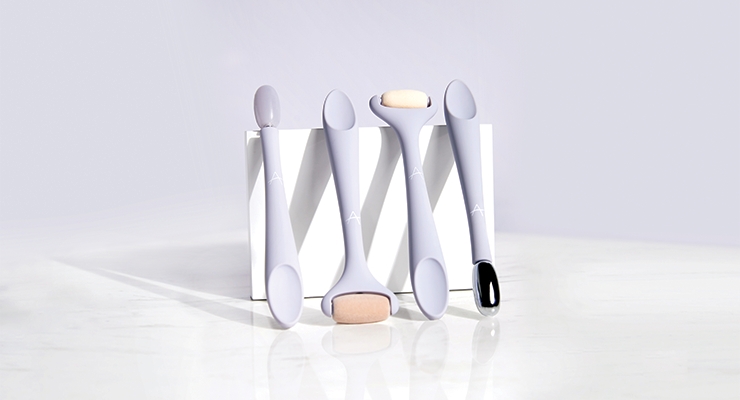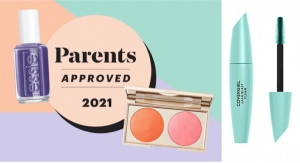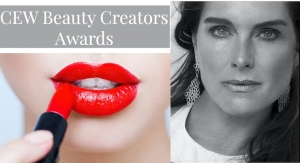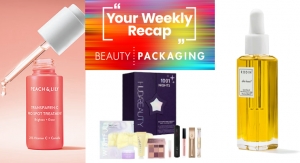Marie Redding, Senior Editor11.01.19
Skincare is a broad category within beauty. Skincare products come in many forms—from eye serums to body butters and facial oils. There are creams, lotions, serums, oils, gels, scrubs, and masks that span the facial care and body care segments. Some products focus on acne, while others are anti-aging, or anti-pollution. And all require different packaging solutions.
Suppliers are developing all types of packaging options to meet the growing demands, from brands and consumers. “Beauty consumers know the standard skincare regimen like the alphabet: Cleanse, Tone, Moisturize. But they also understand additional steps, and using scrubs, serums and eye creams,” says Jing Santos, vice president of sales, Compax.
The team at Compax often fulfills requests for airtight packaging for eye creams, non-abrasive scrubs, and Vitamin C serums. “We also include applicators, such as mini spatulas with masks, to provide brands with everything, turnkey,” Santos says.
Yonwoo/PKG’s team also says skincare brands are increasingly looking for packaging with applicators. “We see an increased interest in our packages with applicators, including our Cooling Ball and Medical Spot applicators—they are really hot right now,” says Kelly Cunningham, marketing, Yonwoo/PKG Group.
K-Beauty still has diehard fans—and experts say American consumers will soon see many more Korean brands reach our shores. J-Beauty hasn’t caught on in the same way—yet. Face masks, eye gels, and face rollers are still immensely popular on Instagram and YouTube, and are all a part of beauty consumers’ obsession with “self-care.” Suppliers are responding with new options for all of these trends, across various product categories.
New Options for CBD Products
When asked about skincare product trends, most experts immediately say, “CBD”—and lately it seems like a new product containing cannabidiol launches every 10 seconds. There are body creams formulated to target inflammation—but there are also new facial skincare products, as well as lip care products, made using some form of the plant.
To meet the needs of skincare brands launching CBD products, Virospack recently developed the first certified child-proof dropper in the beauty industry, The Secure Dropper. It has a specially designed closure that has a safety lock system.
Annie Kim, HCT Group, business development manager, Global Skincare Division, says, “CBD and clean beauty sectors will continue to grow as consumers are becoming more educated in both. There’s still a sense of ambiguity regarding each. Brands that do a better job of defining, educating, or emotionally connecting with consumers on these fronts will have ample room for growth.”
FusionPKG recently helped launch the Cannuka CBD Collection, supplying some of the packaging. “The collection features our polypropylene Jumbo Eclipse package, a lip balm, and jars from our stock Axis and Axis LTE lines,” says Alexander Kwapis, executive director of product design + development. FusionPKG also offers CBD formulas, turnkey. “To meet our customers’ needs, we are continuing to innovate around CBD-infused formulas and have developed a wide range of beautiful formulas and textures for brands to onboard through FusionPKG BeautyLab, our turnkey division,” Jessica Tarangioli, VP of business development, explains.
The Skincare Boom Will Continue
The global skincare products market size is projected to reach $183 billion by 2025, expanding at a CAGR of 4.4%, according to a report by Grand View Research. Body lotion is expected to be the fastest-growing product segment at a CAGR of 5.1% from 2019 to 2025, while the face cream category will remain a market leader.
In the U.S. market, Prestige beauty reached $18.8 billion in 2018 and grew by 6%—while the skincare segment grew by 13%, The NPD Group reports. Skincare sales were $5.6 billion, and natural skincare accounted for more than one-quarter of sales, rising 23%.
Since all these new skincare launches require bottles, jars, and tubes, it makes sense that the skincare packaging market is on the rise as well.
The Global Skincare Packaging market is expected to reach $21.2 billion by 2026, rising from $13.8 billion in 2017, and growing at a CAGR of 4.9% during the forecast period, according to Research & Markets. The “increasing premiumization of skincare” is driving market growth, analysts say.
The majority of skincare packaging is plastic, although glass and metal are being used more often. “Plastic remains as the most preferred material by the manufacturers in the overall market due to its cost-effectiveness, flexibility and wide usage across various beauty applications,” the report states.
Squeezable plastic tubes are a popular choice for mass and prestige skincare brands, and their use is on the rise, according to a report by FactMR. Global sales of squeezable plastic tubes in 2018 surpassed $700 million, and still climbing due to “a growing consumer demand for packaging convenience and ease of application,” the reports states.
Tubes are especially popular for anti-aging products, and are often paired with a specialized applicator tip. Neutrogena Rapid Wrinkle Repair and Dior UV Shield BB Cream are both housed in tubes.
Consumers Want ‘Clinical & Clean’
“Clinical and clean” are what consumers desire in skincare brands, according to The NPD Group. Although the demand for natural brands is on the rise, the majority of skincare brands also use “clinical” ingredients, such as retinol, collagen and hyaluronic acid.
“Consumers are looking for skincare products that contain ingredients with proven efficacy, but they also have growing concerns over ingredient safety,” states Jennifer Famiano, manager & beauty industry analyst, Skincare, NPD Group.
The NPD Group’s Women’s Facial Skincare Consumer Report notes that nearly 50% of women surveyed will research a product online before buying it. Plus—46% of facial skincare users said they have purchased products free of sulfates, phthalates and/or gluten, which is a 6% increase over two years.
Analysts at Grand View Research agree, stating that consumers have “increasing concerns regarding the authenticity of products.” The report says this is encouraging emerging brands to enter the market—and new brands are expected to fuel “intense competition.”
In response, more suppliers that offer turnkey collections are offering “clean” formulas, along with packaging. “Clean beauty development is quickly becoming the new standard and we are seeing brands paying more attention to their ‘black-lists’ and overall ingredient positioning,” says Fusion’s Tarangioli.
Inoac Packaging offers a minimalist look with its range of heavy wall PET bottles and jars that resemble glass. The supplier manufactures custom bottles and jars, and continually offers new shapes and sizes. Some of the supplier’s most popular shapes are shown on the left of this page.
Airless Packaging & Pumps Still Reign
Bottles with airless pumps have typically been the most popular option for skincare over the years, but since new brands are using more glass serum bottles and jars, is their appeal waning? No, suppliers say.
“The demand for airless packaging hasn’t slowed. Brands recognize that airless packaging means a higher perceived value —and meets a growing consumer desire for products that use less chemical preservatives,” says HCT Group’s Kim.
Pumps with a locking mechanism, such as HCT Group’s Twist Zoom, is often requested. “This pump is highly sought after, as customers live a more mobile lifestyle and appreciate spill-free, mess-free packaging,” says Kim.
Kim advises brands to choose the right pump. “Making sure the pump is compatible with the formula and dispenses the right amount is always incredibly important, especially for prestige brands. Application is a huge part of the customer experience, and so much of luxury is about experience,” she explains.
HCT Group also offers a unique Pull Down Pump. It looks like a pen, with a wider diameter—and it combines airless technology with a unique dispensing system that makes product application easy. The user can apply the product directly to the skin, with one simple motion, by lifting off the over cap, and pressing the angled dispensing tip directly to the skin. It is ideal for both cosmetic and skincare products.
FusionPKG offers a wide range of airless packaging options, including bottles and jars. “Airless packaging demand is not slowing,” says Lesley Gadomski, president, West Region. “As we continue to see the clean formula trend on the rise, formula protection is very important and the need for airless packaging will be more important,” Gadomski adds.
FusionPKG says its team of designers and engineers has developed packaging available with interchangeable pump engines, actuators, collars, and bottles, which allow a brand to mix and match finishes, styles, materials, decorations, as well as accommodate a range of dosage requirements for different products. “We can help a brand get to market quickly with a package that is perfect for their formula,” adds Gadomski.
Glass Gets Its Time to Shine
Indie brands often say that glass is a preferred packaging material—and Ona New York is one example. In sync with packaging and product trends, Ona New York has a clinical look, and “clean” ingredient list. “We choose our ingredients carefully, focusing on ingredients found in nature that have stood the test of time,” says co-founder Olga Kovaleva. She founded the brand with Oksana Sannikova.
Ona New York launched in September, and the skincare line includes glass serum bottles, plastic tubes, and glass jars. “Our Hydrating Cream is in a glass jar, because it provides easy access and application. Our Rejuvenating Serum is also glass. We want the packaging to be as eco-friendly as possible, and glass can be infinitely recycled,” Kovaleva says.
The brand’s minimalist aesthetic, and classic shapes, were inspired by the past. “Our moms and grandmothers, in Eastern Europe, used to prepare home remedies, keeping them in glass or clay jars and bottles,” Sannikova says. “So the inspiration for some of our products dates back to our childhood,” she adds.
Organizers of the recent ADF&PCD New York show also report that many visitors said they were looking for glass packaging at the show. Suppliers are hearing requests as well, and responding with new packaging options.
“Glass is still the best packaging choice for cosmetics,” states Virospack’s Rosa Porras Mansilla, marketing and communications manager. Virospack is known for its droppers, and offers a “full dispensing pack” that includes a tubular glass bottle and a dropper. “Our Class 1 tube glass is strong, lightweight, and resistant,” she says. The best finish is achieved when using “first class” neutral transparent or amber hydrolytic glass, Porras advises.
Virospack has expanded its range of molded glass bottles with a new “last drop” format that offers a larger capacity— 50ml. “We launched a larger size to respond to the need we heard from brands, for larger size dropper bottles,” says Porras. “It is perfect for oils for the face and body,” she says.
Virospack’s “Last Drop” feature is a unique finish that allows for a restitution below 0.4%, which is lower than the market average, the company says. The new bottle size is compatible with a wide range of droppers in various styles.
Virospack’s factory features a new production unit that is fully automated, with state-of-the-art machinery and technology. The company has made significant investments to ensure cost-efficiency. “We have nine lines to produce vials, and a daily manufacturing capacity of over 90,000 bottles,” says Porras.
Olay Tests Refillable Skincare
P&G’s Olay debuted the first-ever mass market refillable skincare package with the launch of its Olay Regenerist Whip Pink Ribbon Face Moisturizer + Single Use Refill.
The October 1st launch was planned to coincide with Breast Cancer Awareness Month, and 100% of sales will benefit the non-profit organization, Bright Pink.
The pink plastic jar has a shiny silver cap. The face cream is in a plastic pod, made from recycled polypropylene. When the jar is empty, pop a new pod into the jar, and tear off its plastic seal.
How eco-friendly is it? Olay says that swapping 5 million of its moisturizer jars for pod refills would save over one million pounds of plastic. “This could potentially change the way consumers shop for skincare and create a new industry standard,” Olay states.
The Olay Regenerist Whip Pink Ribbon launch is part of Olay’s three-month pilot program to find how well consumers respond to refilling a skincare package. It will be sold while supplies last. After the test run, Olay’s team says it will evaluate the findings to inform future packaging and design decisions.
Anitra Marsh, communications & sustainability leader for P&G’s skin and personal care brands, says, “The ultimate goal is to find and adopt many more sustainable packaging solutions, and this is the first step on that journey. It’s really important for us to get it right because only then can we bring this concept to market at scale.”
Marsh says that the idea for the refillable jar has been “a year in the making,” and the idea originally came from Chris Heiert, Olay’s North American and global vice president.
“Chris asked, ‘Could we even do this?’ and then our R&D and Package Design teams worked to pull together a prototype —and we realized it was very possible,”
Why debut the refillable jar with Olay Regenerist Whip? Because Millennials like the product—and sustainable packaging. “This product was actually designed for women in their late 20s and early 30s in mind—and we know the Millennial consumer is especially concerned about the environment and the impact of the products they use,” says Marsh.
Olay Regenerist Whip was the best-selling new skincare launch in the U.S. in 2018, which made it perfect for the pilot test. Marsh adds, “This program allows Olay’s team to combine our own passions, personally and professionally—creating great products for our consumers and helping the world at the same time.”
Beauty Consumers Are Still Obsessed with ‘Self-Care’
Skincare products such as face masks and eye gels are linked to the wellness trend—and “self-care” is still a buzz word on social media. Suppliers are spotting the trends as well, responding with new types of packaging and beauty accessory options —such as face rollers.
Anisa International recently launched the Multi-Function Complexion Roller Duo, which “takes facial roller technology to the next level,” the company states.
The set of multi-product, interchangeable roller heads features four innovative materials, for an optimal application experience—depending on the type of product you’re applying.
The facial rollers massage the face while applying products to the skin, delivering the added benefits of increased circulation and lymphatic drainage.
What’s Next?
Two major trends already on the market are multi-tasking products, including color cosmetics that offer skincare benefits, and customizable skincare. Suppliers say we’re likely to see more products in these categories soon.
The team at HCT says that on the formula-front, multi-tasking products are more popular than ever. “They help streamline beauty routines. We’re seeing more primers, lip balms with SPF, and even mascaras infused with skincare ingredients that provide unique benefits, such as lash growth,” says Kim.
The team at Compax says upcoming trends will include more personalized skincare products, and customized packaging. Santos says, “Beauty consumers are continually faced with a rapidly growing selection of products, especially in skincare. Package design will often be the deciding factor in which brands they choose.”
In addition, Santos says, “We always aim to create, customize and manufacture packaging that best suits a brand’s unique DNA. Whether modifying stock-ready items or customizing unique components, it all circles around to making sure the packaging elevates the product.”

























